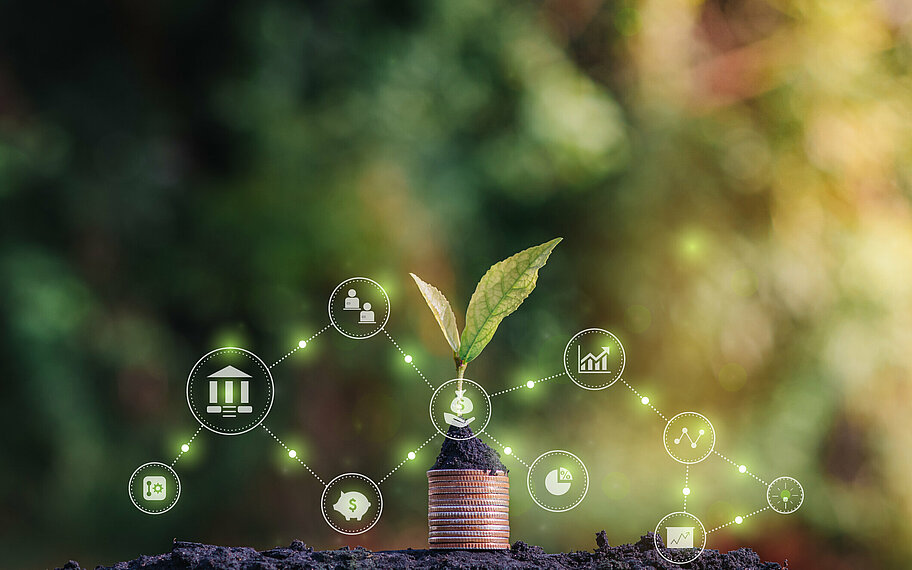The opportunities of DeFi (Decentralized Finance) have widely been discussed over the last years (see our article on regulations and the FinTech track of the Blockchain in Use Conference 2022) and becoming more and more relevant against the background of the MiCA regulation and the aspirations of the European Central Bank regarding a “Digital Euro”. With a stronger focus on sustainable transformation now further extends the discussions around DeFi. ReFi (Regenerative Finance) is a holistic and progressive approach to financial systems, economic, environmental, and social aspects at the same time to gain long-lasting sustainability, regeneration, and resilience. The expectations of such a complex approach are as diverse as their functional areas of applications. Initiatives such as PositiveBlockchain.io, the IOTA Foundation, INATBA, or Climate Collective, to name a few, are thriving to reach the common goal of a purpose-driven ecosystem. By defining new standards, they make significant progresses on how to apply blockchain for good. Celebrating their 5th anniversary this June in Berlin, PositiveBlockchain.io hosted their three days anniversary event to share successful use cases and knowledge on how to be collaborative. Watch the video for exclusive insights of some of their keynote speakers below.
While DeFi revolutionizes traditional financial systems by removing intermediaries and centralized infrastructure to provide open and inclusive access to financial services. Its primary focus remains on financial capital and economic rewards. The ReFi community aims to tackle issues of inequality, climate challenges, and finite resources. Rooted in the principles of regenerative economy, ReFi goes beyond financial returns by promoting ecosystem preservation, community empowerment, and wealth generation. It involves local communities by offering incentives for conserving valuable natural ecosystems such as forests, marine areas, and protected zones. Money becomes a catalyst for sustainability as stakeholders work together to create a more inclusive financial system that prioritizes people and our planet - and it can thrive on energy-efficient blockchain networks.
One might wonder why ReFi needs its own terminology. Drawing from a conversation between Alison Filler, community lead at Climate Collective and her friend, the explanation is simple: "It is difficult to describe new behavior with old language." This statement is true today as more individuals align with these shared values. There is a pressing need to improve the reputation of blockchain technologies tainted by past crypto market volatility and scandals. Additionally, debunking the myth that blockchain is inherently energy-intensive is crucial. As climate finance meets web3 solutions, this novel term can outline guiding principles and establish a united vision for sustainable web3 developments.
Blockchain for Sustainability
Blockchain can be conceived as a technology that brings more accountability and credibility to climate initiatives. How? By allowing everyone to see and verify the environmental impact of these actions in a transparent manner. That can be imagined like a public diary where all the valuable information is securely written and easily accessible. For instance, let us consider sustainability claims in carbon accounting and Environmental, Social, and Governance (ESG) data reporting. Blockchain technology can support sharing and maintaining crucial data about climate, carbon, biodiversity, and other vital areas affecting the environment and society. This empowers everyone to stay informed, ensuring alignment as society and economy collectively progress towards a more sustainable future.
Lucas Zaehringer, founder of Positive Blockchain, mentions: "It is not only about issuing a token representing a carbon credit or an environmental project, but also making sure all the outcomes of this project (beyond carbon only), are being tracked (and not only assumed or defaulted), measured, and reported properly."
Indeed, maintaining transparent and immutable transaction records can prevent greenwashing, double-counting, or false claims about environmental goals.
Another vital aspect is the network's governance and capacity to coordinate various stakeholders. It ensures alignment when working toward common objectives like the Sustainable Development Goals (SDGs). It provides all parties with a single source of truth on the market's state, leading to more efficient pricing, reduced transaction costs, and improved trust for sustainable development.
By harnessing this technology's possibility, new financial instruments can be developed for ecological and carbon credits and other incentives that empower local communities to make informed and environmentally conscious decisions. Hence, blockchain networks with regenerative principles may serve as a powerful tool promoting sustainability and climate action in many ways.
Collaboration is key
Unlocking the full potential of ReFi and blockchain technology for climate action is a journey fraught with challenges that must be faced head-on. One pressing issue is the uncertainty around regulations and the need for clear guidelines, making it difficult for people to invest in and adopt these innovative solutions.
The ideal regulatory framework, according to Mariana de la Roche Wills, INATBA board member and IOTA regulatory affairs expert: "should be based on the principle of proportionality. It should strike a balance between fostering innovation and protecting consumers and investors. It should also incentivize and promote sustainable and regenerative practices across industries. This framework should embrace a collaborative approach involving the industry, projects, and communities in the regulatory conversation. By including diverse perspectives and engaging stakeholders at all levels, we can ensure that regulations are informed by practical knowledge and real-world experiences."
Another obstacle is global adoption. ReFi - like most blockchain technologies use cases - currently exists within its own niche. Silos must be connected to promote greater accessibility and foster multistakeholder partnerships that unite traditional organizations with innovative solution providers.
Legacy systems and companies play a pivotal role in this process. By partnering with startups, blockchain projects, and industry experts, they can assimilate innovative ideas while leveraging their expertise. This keeps them relevant in an ever-evolving ecosystem. Ultimately, these collaborations can help to bridge the gap between conventional financial systems and the emerging decentralized and regenerative finance world.
Alison Filler emphasizes: “As much as possible, we need to encourage collaboration among teams and interoperability of tools. We have a lot more to gain by working together than by directly competing at this stage, and open-source technology that anyone around the world can build upon is key to developing innovations efficiently and driving the adoption of new tools at the greatest scale.”
Berlin x ReFi
Berlin has the potential to advance this field by facilitating communication and cooperation between local projects, industry players, and regulators, thereby fostering the development of impactful solutions. Several ReFi initiatives are based in Berlin:
-
Atem: Atem is an API and web interface that connects directly to dozens of carbon markets and automates the process of sourcing, buying, and retiring carbon credits for companies. See: https://www.atem.earth/
-
cLabs: cLabs is a technology company that accelerates the adoption of the Celo platform, providing infrastructure, tools, and support for developers and entrepreneurs to create decentralized applications, mobile payment solutions, and inclusive financial services. See: https://clabs.co/ & https://celo.org/
-
Curve Labs: Curve Labs is an innovation network working with web3 primitives to provide mechanism design, front and back-end development, thought leadership, UX/UI design, and project management services, with special attention to composable design, regenerative finance, and user data sovereignty. See: https://www.curvelabs.eu/
-
Senken: Senken is a blockchain-based marketplace platform for anyone to buy, retire, and sell carbon credits from verified climate projects, featuring the largest selection of climate assets in the world. See: https://www.senken.io/
-
Toucan: Toucan is a blockchain protocol that tokenizes carbon credits, making them more liquid and easily interchangeable between creators and buyers of carbon credits. See: https://toucan.earth/
Sources:
-
Climate Collective: Climate Collective is a leading coalition of stakeholders with the mission of building a trusted market for high-quality, digital environmental assets that enable people and the planet to thrive. By using mass-coordination tools to solve mass-coordination problems, planetary health and a regenerative financial system shall be advanced, https://climatecollective.org/
-
INATBA: INATBA facilitates positive change in the blockchain ecosystem and is dedicated to support and promote their members to bridge public and private entities and promote global blockchain adoption across diverse fields such as law, finance, and education, https://inatba.org/
-
IOTA: “IOTA is the first distributed ledger built for the “Internet of Everything” - a network for exchanging value and data between humans and machines”, https://www.iota.org/
-
Positive Blockchain: “Positive Blockchain is a non-profit association exploring the potential of blockchain technologies for social and environmental impact through its open database, knowledge platform and global community”, positiveblockchain.io/
-
WEF (2023): Blockchain for Scaling Climate Action. White Paper.




